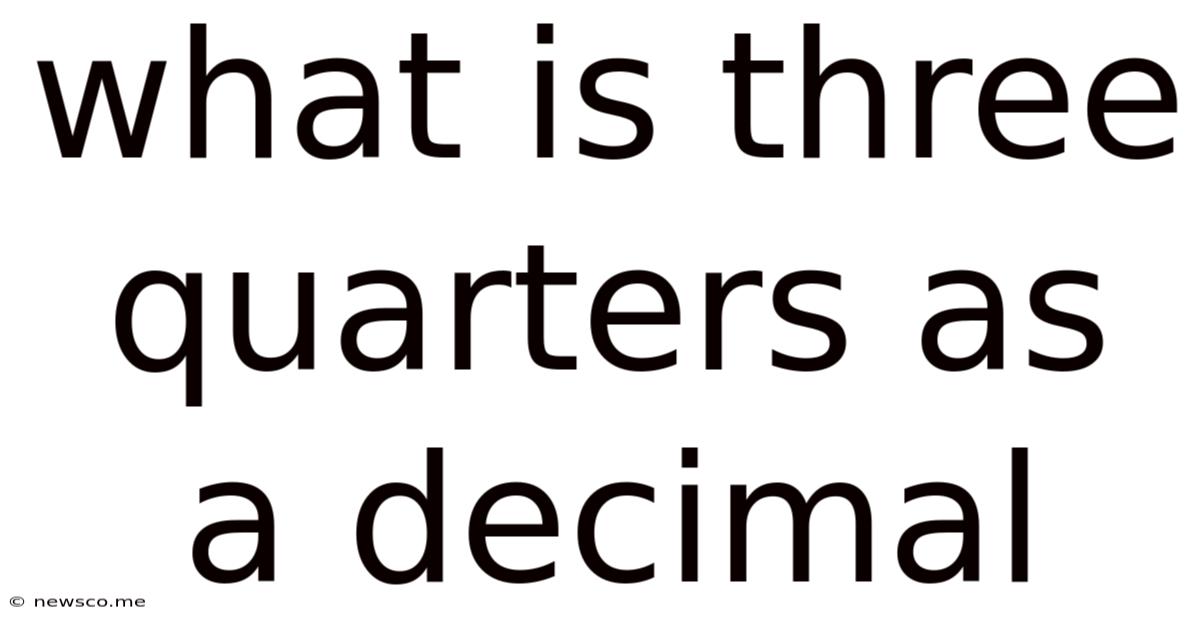What Is Three Quarters As A Decimal
News Co
Mar 16, 2025 · 5 min read

Table of Contents
What is Three Quarters as a Decimal? A Comprehensive Guide
Understanding fractions and their decimal equivalents is a fundamental skill in mathematics. This comprehensive guide will delve deep into the question: What is three quarters as a decimal? We'll explore the conversion process, provide multiple methods for solving this, and discuss the broader implications of understanding fractional-to-decimal conversions.
Understanding Fractions and Decimals
Before we dive into the specific conversion of three-quarters, let's refresh our understanding of fractions and decimals.
Fractions represent parts of a whole. They are expressed as a ratio of two numbers: the numerator (top number) and the denominator (bottom number). The denominator indicates how many equal parts the whole is divided into, and the numerator indicates how many of those parts are being considered. For example, in the fraction ¾ (three-quarters), the denominator (4) means the whole is divided into four equal parts, and the numerator (3) means we're considering three of those parts.
Decimals are another way of representing parts of a whole. They use a base-ten system, where each place value to the right of the decimal point represents a power of ten (tenths, hundredths, thousandths, etc.). For example, 0.75 represents 7 tenths and 5 hundredths.
Converting Three-Quarters to a Decimal: Method 1 - Division
The most straightforward method for converting a fraction to a decimal is through division. We simply divide the numerator by the denominator.
In the case of three-quarters (¾):
- Divide the numerator (3) by the denominator (4): 3 ÷ 4 = 0.75
Therefore, three-quarters as a decimal is 0.75.
This method is universally applicable to any fraction. Simply divide the top number by the bottom number to obtain its decimal equivalent.
Converting Three-Quarters to a Decimal: Method 2 - Equivalent Fractions
Another approach involves converting the fraction to an equivalent fraction with a denominator that is a power of 10 (10, 100, 1000, etc.). This allows for a direct conversion to a decimal.
While not always feasible for all fractions, it works well for ¾. We can convert the denominator 4 to 100 by multiplying it by 25. However, to maintain the equivalence of the fraction, we must also multiply the numerator by 25:
- (3 x 25) / (4 x 25) = 75/100
Since 75/100 represents 75 hundredths, we can directly write this as a decimal: 0.75
This method highlights the relationship between fractions and decimals and provides a visual understanding of the conversion.
Understanding the Decimal Value: 0.75
The decimal 0.75 represents seventy-five hundredths. This means it's equivalent to 75 out of 100 equal parts. Understanding this representation allows for easier visualization and application in various contexts.
Practical Applications of 0.75
The decimal 0.75 appears frequently in everyday life and various applications:
-
Percentages: 0.75 is equivalent to 75% (0.75 x 100 = 75). This is often used to represent proportions, discounts, or progress. For instance, completing three-quarters of a task means 75% completion.
-
Measurements: In metric measurements, 0.75 meters is equivalent to 75 centimeters (1 meter = 100 centimeters). Similarly, this applies to other metric units like liters, grams, etc.
-
Finance: 0.75 can represent a fractional share of ownership or a portion of a financial instrument.
-
Data Analysis: In statistics and data analysis, 0.75 might represent a correlation coefficient or a quantile within a dataset.
Expanding on Fractional-to-Decimal Conversions: More Complex Examples
While ¾ is a relatively simple conversion, let's explore more complex scenarios to reinforce the understanding of the process.
Example 1: Converting 2/3 to a decimal
Dividing 2 by 3 results in a recurring decimal: 0.6666... This is often represented as 0.6̅. Recurring decimals highlight that not all fractions have finite decimal equivalents.
Example 2: Converting 5/8 to a decimal
Dividing 5 by 8 gives us 0.625. This demonstrates that fractions with denominators that are factors of powers of 10 can also result in finite decimals.
Example 3: Converting 1/7 to a decimal
Dividing 1 by 7 yields a recurring decimal: 0.142857142857... This is represented as 0.1̅4̅2̅8̅5̅7̅. The repeating pattern is six digits long.
The Importance of Mastering Fraction-to-Decimal Conversions
The ability to confidently convert fractions to decimals is crucial for various mathematical and real-world applications. It strengthens your understanding of number systems, enhances problem-solving skills, and improves accuracy in calculations.
Benefits of Understanding Decimal Equivalents:
-
Improved Calculation Accuracy: Decimal representation often simplifies calculations, particularly when working with calculators or computer programs.
-
Easier Comparisons: Comparing fractions can be challenging, but comparing their decimal equivalents is often more intuitive.
-
Enhanced Problem-Solving Skills: Fluency in converting between fractions and decimals enhances your overall mathematical problem-solving ability.
-
Real-World Applications: As seen earlier, decimal equivalents are essential in diverse fields like finance, engineering, and science.
Conclusion: Three-Quarters and Beyond
We've comprehensively explored the question, "What is three-quarters as a decimal?", establishing that the answer is 0.75. We've examined two different methods for arriving at this answer and discussed the broader implications of understanding fractional-to-decimal conversions. Mastering this conversion skill will significantly improve your mathematical proficiency and expand your ability to tackle complex problems across various fields. Remember that the core principle lies in the division of the numerator by the denominator, a process applicable to all fractions, leading to either a finite or recurring decimal value. Understanding the underlying concepts will allow you to confidently handle any fraction-to-decimal conversion you encounter.
Latest Posts
Related Post
Thank you for visiting our website which covers about What Is Three Quarters As A Decimal . We hope the information provided has been useful to you. Feel free to contact us if you have any questions or need further assistance. See you next time and don't miss to bookmark.